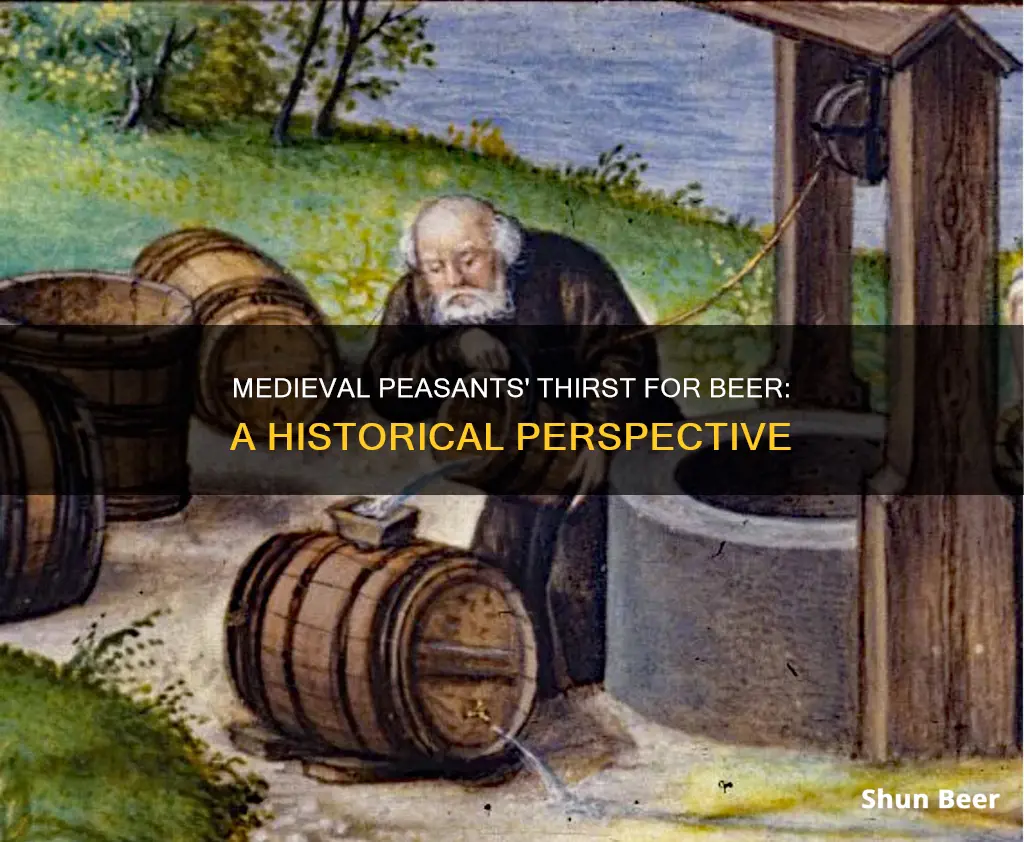
The idea that medieval peasants drank beer instead of water is a myth. While water sources in the Middle Ages were generally safe to drink, beer was also consumed. In the Middle Ages, beer was a calorie-laden beverage that was weakly brewed from barley. It was also more expensive than water, which was free and available from wells or fresh streams. Beer was also used to pay taxes and tithes. The amount of beer consumed would have depended on class, with lower classes drinking weak beer, the middle classes and wealthier peasantry drinking ale, and the aristocracy drinking wine.
| Characteristics | Values |
|---|---|
| Average consumption of ale per week by an English peasant in the first half of the 14th century | Less than half the UK government’s recommended maximum alcohol intake for English peasants in the first half of the 21st century |
| Average consumption of ale per year by an English peasant in the first half of the 14th century | 15.37 gallons of ale per adult per year |
| Average consumption of ale per day by an English peasant in the first half of the 14th century | 1/3 of a pint of ale per day |
| Average consumption of ale per week by an English peasant in the first half of the 14th century | 2.36 pints of ale per week |
| Percentage of total crop production that was malted | 8% |
| Percentage of total grain production that would have been required to be used for brewing to supply every adult in the country with 3.5 pints of ale a day | 83% |
| Percentage of total grain production that would have been required to be used for brewing to supply every adult in the country with 1 pint of ale a day | 19% |
What You'll Learn

Water was free and clean
In larger towns, there were even infrastructures to supply water to citizens. In 1236, construction began on a system of pipes in London. It was designed to move water from a fresh spring to a pumping house, which would, in turn, make fresh water available at cisterns throughout the city.
Medical texts and health manuals throughout the Middle Ages often noted the benefits of drinking water. For example, Paul of Aegina, a 7th-century Byzantine physician, wrote:
> "Of all things, water is of most use in every mode of regimen. It is necessary to know that the best water is devoid of quality as regards taste and smell, is most pleasant to drink, and pure to the sight; and when it passes through the praecordia quickly, one cannot find a better drink."
The Salernitan Rule of Health advised that drinking from a cool spring was good for thirst, but rainwater was even better.
In addition to being clean and free, water was also the centerpiece of villages. Whether from a well or fresh stream, it was readily available.
Beer and Angioplasty: What You Need to Know
You may want to see also

Beer was used to pay taxes and tithes
Beer was a common currency in the Middle Ages, often used to pay taxes and tithes. The 15th-century bishop of Tournai, for example, is recorded as receiving a tithe of beer from tenants on his lands.
Beer was also used as payment for workers, who were often remunerated with jugs of beer. In some cases, beer was even used to raise money for the church or to support people in financial difficulty. This type of beer, known as "church-ale", was similar to the beer we drink today.
Beer was a valuable commodity, considered a potable foodstuff, and it played a significant role in daily life. It was so sought-after that it is believed to have led nomadic groups to settle down and establish village life. Beer was also an important source of nutrition for medieval people, particularly "small beer" or "table beer", which was highly nutritious, contained just enough alcohol to act as a preservative, and provided hydration without intoxicating effects.
The production and sale of beer also provided a substantial supplemental income for many families, especially widows, for whom brewing was considered the primary source of household income.
Antidepressants and Alcohol: Is Drinking Beer Safe?
You may want to see also

Beer was a nutritious alternative to water
In the 7th century, Byzantine physician Paul of Aegina wrote that "of all things water is of most use in every mode of regimen. It is necessary to know that the best water is devoid of quality as regards taste and smell, is most pleasant to drink, and pure to the sight; and when it passes through the praecordia quickly, one cannot find a better drink." The Salernitan Rule of Health advised that drinking from a cool spring was good for thirst, but rainwater was even better.
In the Middle Ages, beer was considered a valuable (potable) foodstuff, and workers were often paid with jugs of beer. Beer was clearly so desired that it led nomadic groups into village life. Beer was also used to pay taxes and tithes. In the 15th century, the bishop of Tournai was shown receiving a tithe of beer from tenants on his lands.
Ale, a drink similar to beer but without hops, was also an important source of nutrition in the medieval world, particularly small beer, or table beer, which was highly nutritious, contained just enough alcohol to act as a preservative, and provided hydration without intoxicating effects. Small beer was consumed daily by almost everyone in the medieval world, with higher-alcohol ales served for recreational purposes.
In some places, even children drank ale. Brewing ale in the Middle Ages was a local industry primarily pursued by women, who would brew in the homestead for both domestic consumption and small-scale commercial sale.
Beer and the Bible: Drinking Guidelines
You may want to see also

Beer was costly to drink
In the Middle Ages, beer was viewed as a more nutritious alternative to water. Even though it was weakly brewed from barley, beer was a calorie-laden beverage that was perfect for workers and farmers who were thirsty and in need of energy.
The calorie-dense nature of beer meant that it was not a sustainable option for peasants to drink beer all day, every day. A medieval peasant would have needed to consume around 10 pints of weak ale to meet their daily calorie requirements. This would have been extremely costly, and the majority of peasants would not have been able to afford this.
In addition, the amount of grain required to produce enough beer for the entire population of England to consume the recommended liquid intake of 3.5 pints a day would have been 83% of the country's total grain production. This is clearly not feasible, and it is much more likely that peasants drank water as their primary source of hydration.
Furthermore, the process of brewing, storing, and transporting beer in large quantities would have been logistically challenging and costly. This was especially true for urban populations, who may have had less access to clean water supplies and relied more on beer as a result.
Overall, while beer may have been consumed by medieval peasants, it was likely a special occasion drink rather than an everyday beverage due to its cost.
Beer and Wheat Allergies: Is Drinking Safe?
You may want to see also

Beer was home-brewed
Beer was considered a valuable and potable foodstuff, and workers were often paid with jugs of beer. It was also used to pay taxes and tithes. Beer was commonly viewed as a more nutritious alternative to water, and it was calorie-laden, which made it ideal for thirsty workers and farmers who needed energy.
The process of brewing beer started with boiling grain and leaving it to ferment for several days until it had a slight alcohol content of 1-2.5%. The beer drunk by the lower classes was typically weak, while the middle classes and wealthier peasantry tended to have ale, which is similar to our modern-day beer. The aristocracy drank wine and ale.
In the Middle Ages, beer was also considered healthier than water, which was often contaminated by bacteria, whereas the ethanol in beer kills bacteria. Beer was also safer to drink than water because water sources were sometimes polluted and full of bacteria. However, medieval people were not stupid; they did not drink water that looked or smelled bad, and tradesmen who used water, such as tanning, faced hefty fines if they polluted the town's drinking supply.
In larger towns, there were infrastructures to supply water to citizens. For example, in 1236, construction began on a system of pipes in London, designed to move water from a fresh spring to a pumping house that would make fresh water available at cisterns throughout the city.
Kids Drinking Beer at Baseball Games: What's the Deal?
You may want to see also
Frequently asked questions
No, medieval peasants did not drink beer instead of water. Water was the most common drink owing to its affordability and availability. Beer was also viewed as a more nutritious alternative to water, but it would have been more costly to drink than water.
Medieval peasants drank remarkably little beer. Beer was costly to drink as it had to be purchased, whereas water was free.
The beer drunk by medieval peasants was typically weak beer, with a slight alcohol content of 1-2.5%.
Medieval peasants also drank wine, mead, cider, and milk.







